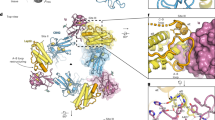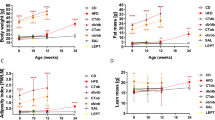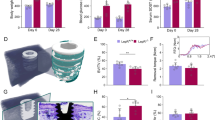Abstract
Background:
Leptin-deficient mice (Lepob/Lepob, also known as ob/ob) are of great importance for studies of obesity, diabetes and other correlated pathologies. Thus, generation of animals carrying the Lepob gene mutation as well as additional genomic modifications has been used to associate genes with metabolic diseases. However, the infertility of Lepob/Lepob mice impairs this kind of breeding experiment.
Objective:
To propose a new method for production of Lepob/Lepob animals and Lepob/Lepob-derived animal models by restoring the fertility of Lepob/Lepob mice in a stable way through white adipose tissue transplantations.
Methods:
For this purpose, 1 g of peri-gonadal adipose tissue from lean donors was used in subcutaneous transplantations of Lepob/Lepob animals and a crossing strategy was established to generate Lepob/Lepob-derived mice.
Results:
The presented method reduced by four times the number of animals used to generate double transgenic models (from about 20 to 5 animals per double mutant produced) and minimized the number of genotyping steps (from 3 to 1 genotyping step, reducing the number of Lep gene genotyping assays from 83 to 6).
Conclusion:
The application of the adipose transplantation technique drastically improves both the production of Lepob/Lepob animals and the generation of Lepob/Lepob-derived animal models.
This is a preview of subscription content, access via your institution
Access options
Subscribe to this journal
Receive 12 print issues and online access
$259.00 per year
only $21.58 per issue
Buy this article
- Purchase on SpringerLink
- Instant access to full article PDF
Prices may be subject to local taxes which are calculated during checkout


Similar content being viewed by others
References
Silventoinen K, Pietiläinen KH, Tynelius P, Sørensen TI, Kaprio J, Rasmussen F et al. Genetic and environmental factors in relative weight from birth to age 18: the Swedish young male twins study. Int J Obes (London) 2007; 31: 615–621.
Rankinen T, Zuberi A, Chagnon YC, Weisnagel SJ, Argyropoulos G, Walts B, Pérusse L, Bouchard C et al. The human obesity gene map: the 2005 update. Obesity (Silver Spring) 2006; 14: 529–644.
Leibel RL . Molecular physiology of weight regulation in mice and humans. Int J Obes (London) 2008; 32: S98–S108.
Lindstrom P . The physiology of obese-hyperglycemic mice [ob/ob mice]. ScientificWorldJournal 2007; 7: 666–685.
Dentin R, Benhamed F, Hainault I, Fauveau V, Foufelle F, Dyck JR et al. Liver-specific inhibition of ChREBP improves hepatic steatosis and insulin resistance in ob/ob mice. Diabetes 2006; 55: 2159–2170.
Mori MA, Araújo RC, Reis FC, Sgai DG, Fonseca RG, Barros CC et al. Kinin B1 receptor deficiency leads to leptin hypersensitivity and resistance to obesity. Diabetes 2008; 57: 1491–1500.
Scrocchi LA, Hill ME, Saleh J, Perkins B, Drucker DJ . Elimination of glucagon-like peptide 1R signaling does not modify weight gain and islet adaptation in mice with combined disruption of leptin and GLP-1 action. Diabetes 2000; 49: 1552–1560.
Schafer K, Fujisawa K, Konstantinides S, Loskutoff DJ . Disruption of the plasminogen activator inhibitor 1 gene reduces the adiposity and improves the metabolic profile of genetically obese and diabetic ob/ob mice. FASEB J 2001; 15: 1840–1842.
Wellen KE, Uysal KT, Wiesbrock S, Yang Q, Chen H, Hotamisligil GS. et al. Interaction of tumor necrosis factor-alpha- and thiazolidinedione-regulated pathways in obesity. Endocrinology 2004; 145: 2214–2220.
Bhoola KD, Figueroa CD, Worthy K . Bioregulation of kinins: kallikreins, kininogens, and kininases. Pharmacol Rev 1992; 44: 1–80.
Araújo RC, Kettritz R, Fichtner I, Paiva AC, Pesquero JB, Bader M . Altered neutrophil homeostasis in kinin B1 receptor-deficient mice. Biol Chem 2001; 382: 91–95.
Mori MA, Araujo RC . Pesquero JBKinin B(1) receptor stimulation modulates leptin homeostasis. Evidence for an insulin-dependent mechanism. Int Immunopharmacol 2008; 8: 242–246.
Araujo RC, Mori MA, Merino VF, Bascands JL, Schanstra JP, Zollner RL et al. Role of the kinin B1 receptor in insulin homeostasis and pancreatic islet function. Biol Chem 2006; 387: 431–436.
Batista EC, Batista EC, Ramalho JD, Reis FC, Barros CC, Moraes MR et al. Swimming training exacerbates pathological cardiac hypertrophy in kinin B(2) receptor-deficient mice. Int Immunopharmacol 2008; 8: 271–275.
Beard KM, Lu H, Ho K, Fantus IG . Bradykinin augments insulin-stimulated glucose transport in rat adipocytes via endothelial nitric oxide synthase-mediated inhibition of Jun NH2-terminal kinase. Diabetes 2006; 55: 2678–2687.
Abe KC, Mori MA, Pesquero JB . Leptin deficiency leads to the regulation of kinin receptors expression in mice. Regul Pept 2007; 138: 56–58.
Haluzik M, Colombo C, Gavrilova O, Chua S, Wolf N, Chen M et al. Genetic background (C57BL/6J versus FVB/N) strongly influences the severity of diabetes and insulin resistance in ob/ob mice. Endocrinology 145; 2004: 3258–3264.
Klebanov S, Astle CM, DeSimone O, Ablamunits V, Harrison DE . Adipose tissue transplantation protects ob/ob mice from obesity, normalizes insulin sensitivity and restores fertility. J Endocrinol 2005; 186: 203–211.
Sennello JA, Fayad R, Pini M, Gove ME, Fantuzzi G . Transplantation of wild-type white adipose tissue normalizes metabolic, immune and inflammatory alterations in leptin-deficient ob/ob mice. Cytokine 2006; 36: 261–266.
Ren S, Li M, Cai H, Hudgins S, Furth PA . A simplified method to prepare PCR template DNA for screening of transgenic and knockout mice. Contemp Top Lab Anim Sci 2001; 40: 27–30.
Qiu J, Ogus S, Mounzih K, Ewart-Toland A, Chehab FF . Leptin-deficient mice backcrossed to the BALB/cJ genetic background have reduced adiposity, enhanced fertility, normal body temperature, and severe diabetes. Endocrinology 2001; 142: 3421–3425.
Chehab FF, Lim ME, Lu R . Correction of the sterility defect in homozygous obese female mice by treatment with the human recombinant leptin. Nat Genet 1996; 12: 318–320.
Mounzih K, Lu R, Chehab FF . Leptin treatment rescues the sterility of genetically obese ob/ob males. Endocrinology 1997; 138: 1190–1193.
Roopenian D, Choi EY, Brown A . The immunogenomics of minor histocompatibility antigens. Immunol Rev 2002; 190: 86–94.
Acknowledgements
We thank MM Oliveira (Universidade de Mogi das Cruzes) and JB Pesquero (UNIFESP, Brazil) for continuing support. This study was supported by grants from FAPESP (06/59081-6), CNPq and CAPES (PROCAD-0216/05-4).
Author information
Authors and Affiliations
Corresponding author
Rights and permissions
About this article
Cite this article
Barros, C., Almeida, S., Mori, M. et al. Efficient method for obtaining Lepob/Lepob-derived animal models using adipose tissue transplantations. Int J Obes 33, 938–944 (2009). https://doi.org/10.1038/ijo.2009.95
Received:
Revised:
Accepted:
Published:
Issue date:
DOI: https://doi.org/10.1038/ijo.2009.95
Keywords
This article is cited by
-
Senolytic treatment reverses obesity-mediated senescent cell accumulation in the ovary
GeroScience (2022)
-
Overexpression of C-type Natriuretic Peptide in Endothelial Cells Protects against Insulin Resistance and Inflammation during Diet-induced Obesity
Scientific Reports (2017)
-
Bradykinin inhibits hepatic gluconeogenesis in obese mice
Laboratory Investigation (2012)



